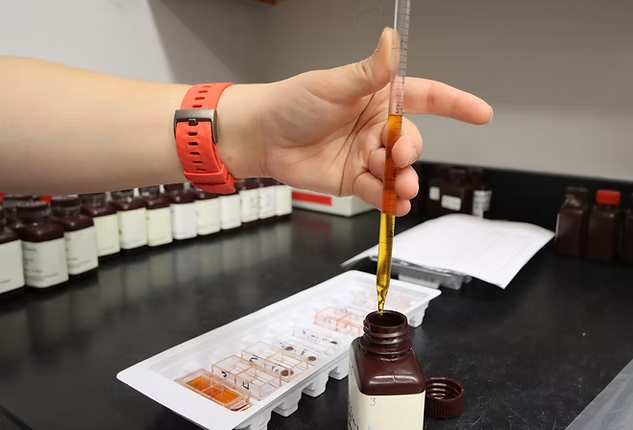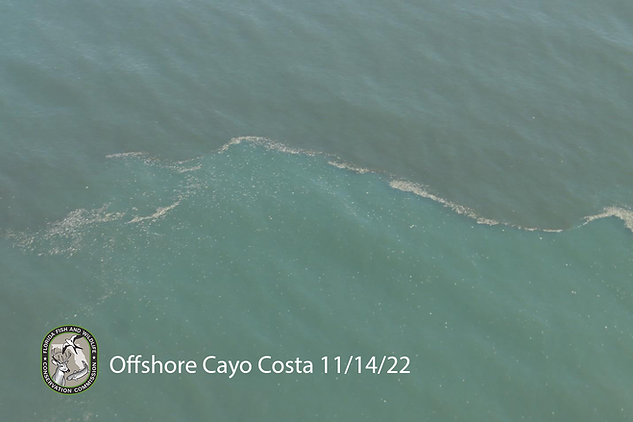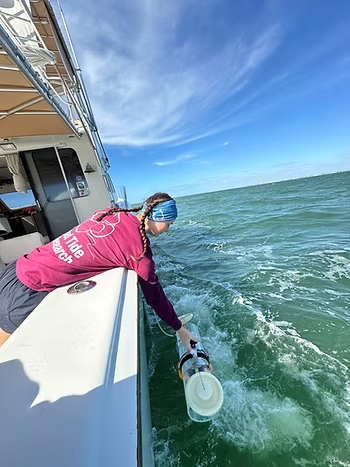By Jillian Kaplan, Florida Student News Watch
The water looks clear until the stench hits. Dead fish rot along the shore, washing up by the hour. Waterfront businesses sit empty.
Red tide, a toxic bloom caused by the algae Karenia brevis, has become nearly an annual menace to Florida’s Gulf Coast. These algae blooms grow when nutrient-rich waters, often coming from natural ocean currents and human-related pollution, feed their spread. The blooms fill beaches with dead fish and irritate residents’ eyes, noses and throats.

A National Oceanic and Atmospheric Administration study made available online in December 2023 found that the financial impact of these repeated red tide events was nearly four times higher than initially expected — a $2.7 billion hit to Southwest Florida for a single, terrible red tide season in 2018. And the hits have kept coming.
In February, a red tide bloom stretched more than 200 miles from Tampa Bay to Key West, prompting health alerts and beach advisories across Southwest Florida. The Florida Fish and Wildlife Conservation Commission (FWC) found the toxic algae in samples gathered from Sarasota, Charlotte and Lee counties. The Karenia brevis bloom growth was linked to nutrient-rich waters stirred up by hurricanes Helene and Milton in 2024.
Despite these efforts, a persistent red tide bloom continues to damage marine life, disrupt local businesses and trigger public health warnings along Florida’s southwest coast. Environmental groups have called on Gov. Ron DeSantis to declare a state of emergency to accelerate response measures, but the governor has yet to issue a statement.
This recurring problem threatens the region’s vital tourism and fishing industries, which generate millions in revenue and support thousands of jobs. As cancellations mount and coastal waters suffer, communities brace for the environmental and economic fallout.
Scientists forecast blooms
Robert Weisberg, an oceanographer with the University of South Florida (USF) and a member of a team that monitors red tide, said the algae bloom is a natural event that has been recorded for hundreds of years. Weisberg studies a massive underwater river in the Gulf of Mexico called the Loop Current.
When the Loop Current reaches the West Florida Shelf, it can set off a circulation pattern that draws deep ocean water across the shelf toward the shoreline. This movement, known as upwelling, alters nutrient conditions in ways that can either promote or suppress red tide blooms. By studying these ocean dynamics, scientists are now better equipped to forecast when and where red tide is most likely to appear.

“The movement of the water, the ocean circulation, is as important to red tide ecology as the organism’s biology,” Weisberg explained. His team uses computer models to track ocean circulation patterns and predict when and where red tides will occur.
Weisberg noted his team’s forecasts provide about 80% accuracy and give officials months of notice to prepare for environmental and economic impacts.
Scientists use several tools to monitor red tide more precisely as it develops. Satellite imagery from NOAA monitors algae concentrations over large areas. Similarly, Mote Marine Laboratory’s Beach Conditions Reporting System gathers local observations and environmental data from coastal areas to help detect and track red tide impacts such as water discoloration, fish kills, and respiratory irritation. In addition, underwater gliders, such as those from USF, collect real-time data on water conditions such as temperature and salinity.
Meanwhile, the FWC updates a Daily Sample Map that tracks water samples collected over the previous eight days. The map updates daily and lets the public explore detailed sampling results by clicking on specific locations to stay aware of current red tide conditions.
The latest red tide forecast on the site reported zero occurrences of the algae along Florida’s coasts in the last week. But even with early warnings, the economic fallout is often unavoidable due to the unpredictable nature of red tide.
Local businesses face losses
In Sanibel and Captiva, red tide is already disrupting daily business. Tourism and outdoor recreation are key economic drivers, and local businesses are seeing cancellations as the bloom spreads along the coast.

“Outdoor recreation is a huge component of our economy,” said John Lai, the CEO of the Sanibel Captiva Chamber of Commerce, told the News Watch. He pointed to the 2018 bloom, which shut down fishing guides for about six months and caused a sharp drop in resort occupancy.
During the bloom, hotels and restaurants saw cancellations for weeks. Shellfish farms lost entire seasons. Health risks also rise when algae toxins become airborne, causing respiratory issues.
According to Lai, the unpredictability of red tide has shortened the booking window from six months to about six weeks, making it harder for local businesses to plan.
“It’s very difficult to plan around or forecast,” he said. “Fishing guides and water-based attractions still take reservations in hopes the bloom will clear, but they really have no idea what conditions will be six months out.” As a result, businesses are left scrambling to adjust to last-minute changes.
Lai also pointed to a 2024 study conducted by Greene Economics, which found that a single harmful algal bloom could cost Lee County up to $5.3 billion in losses related to outdoor recreation and quality of life.
He noted that recovery times vary depending on the timing and severity of a bloom. “It may take a hotel a month or a restaurant a month to recover. It may take property values a year and a half. It may take hotels six to eight months to recover,” Lai said.
Captain Brian Holaway, who runs boat tours out of Sanibel, said media coverage often causes blanket cancellations, even when the bloom is not nearby.
“People cancel trips even when the red tide isn’t directly in our area,” he said. “Just seeing news coverage makes some decide to skip Florida altogether.”
Calls for action and funding
In response to ongoing red tide concerns in 2024, the Florida Legislature passed HB 1565, reauthorizing the Florida Red Tide Mitigation and Technology Development Initiative at Mote Marine Laboratory. This initiative focuses on developing and testing technologies to reduce the severity and impact of red tide events.
The bill also streamlines the regulatory process to help bring these new technologies from the lab to the water more quickly.
But some longtime red tide watchers say that technology alone won’t solve the problem. They suggest more basic solutions. One of these is better sewer practices, so that human waste doesn’t leak into waterways and aggravate the red tide blooms.
“We shouldn’t make excuses for problems we know need fixing. So, fix them,” Weisberg said. He pointed to work needed to upgrade sanitary sewage systems on Florida’s west coast, balancing out rapid development.
Cities across Florida are taking steps to reduce nutrient pollution, which fuels red tide. Measures include banning fertilizer use during rainy seasons, upgrading sewage systems and installing retention ponds.
These ponds temporarily hold stormwater, allowing pollutants and excess nutrients to settle before flowing into rivers or the ocean. Solutions will be complicated.
“With that growth comes increased human impact, and addressing that is more urgent than simply trying to kill red tide,” Weisberg said.
This story was originally edited by Florida Student News Watch mentor Alex Harris. It was originally published at https://www.studentnewswatch.org/post/while-forecasting-is-improving-for-toxic-red-tide-southwest-florida-still-fears-economic-pain. Banner photo: A sign warns of red tide off the coast near Naples. (iStock image).
Sign up for The Invading Sea newsletter by visiting here. To support The Invading Sea, click here to make a donation. If you are interested in submitting an opinion piece to The Invading Sea, email Editor Nathan Crabbe at nc*****@*au.edu.



